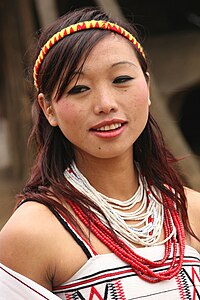Yimchunger
|
A Yimchunger Naga woman at the morung of Kutur village
|
|
| Languages | |
|---|---|
| Yimchungrü language | |
| Related ethnic groups | |
| Other Naga tribes |
Yimchunger is one of the major Naga tribes of Nagaland and the Tuensang district within India and areas of Burma. Increased tourism to the region has brought new life to many in Nagaland. Tourism has been supported and encouraged by the locals in the form of shows and demonstrations of the life and customs of the Yimchunger.
The word Yimchunger means "the ones who have reached their place of choice". It is rendered various ways, including:
They are also known as the Yachumi (also Yatsumi or Yachimi), which is a Sema-influenced name.
According to the Yimchunger tradition, the tribe emerged at a village called Moru and then came to Jure village. The Yimchungers and the Khiamungans are believed to have migrated to the present-day Nagaland from Upper Burma as one group, in one wave. They separated into two groups at the Moru village.
Strong ties to cultural identity in the form of their love and passion for agriculture are reflected in the hymns and beats of songs devoted to the craft.
The musical instruments of the Yimchungers include simple log drums, trumpets and flutes, similar to that of the Angamis.
The traditional dress of the Yimchungers includes colorful cane-made headgear decorated with hair and bird feathers.
The Government of Nagaland has been instrumental in providing the proper tools and venues for the Yimchunger to properly share their traditions, culture, and craft with tourists. Over the last decade, an explosion of tourism in the region has catapulted attempts at preserving the culture of the relevant tribes. The Yimchunger have been at the forefront of preserving culture in the region due to their dedicated festivals aided in part by the Naga State. The Yimchunger are one of the main contributors to the Hornbill Festival in the Naga State of India, the Hornbill festival showcases culture and customs from the different tribes of the Naga region. Highlights of the festival include: tribal dances across the many groups of the Naga region, spin top demonstrations by the Yimchunger, and folk songs. Since most of the Yimchunger and other Naga region people depend on agriculture as a main source of income there are live harvesting demonstrations at the festival. Other demonstrations include harvest songs, cultural performances, and a very interesting traditional way of finding a bride.
...
Wikipedia

